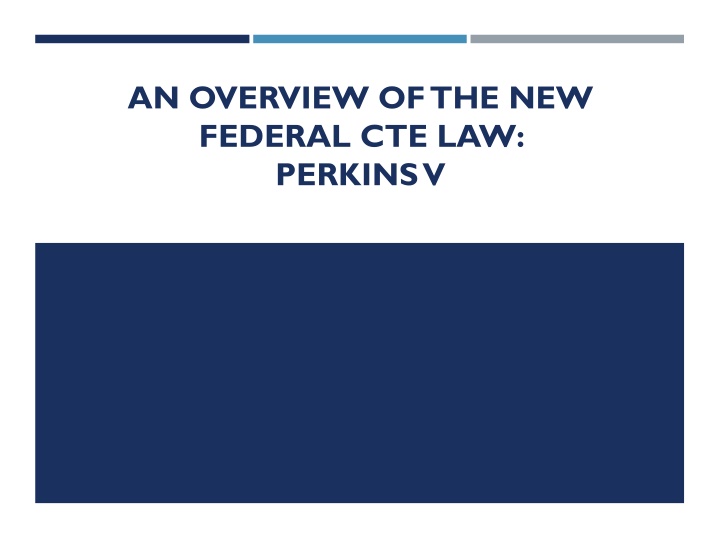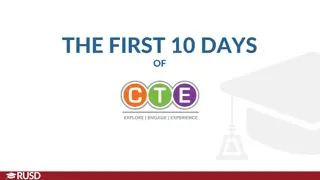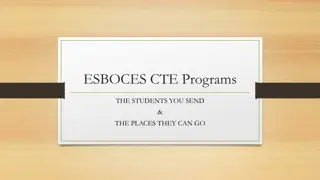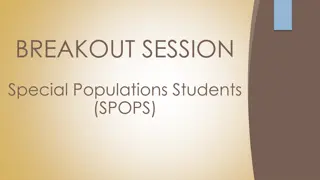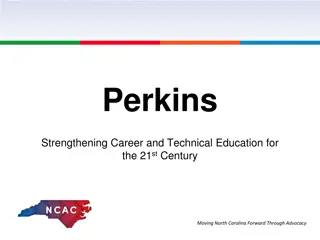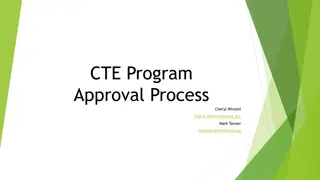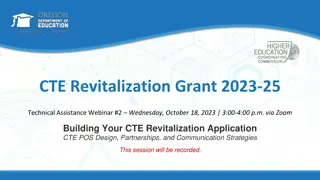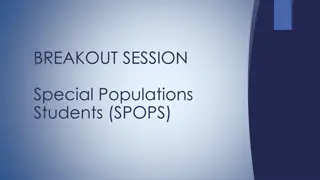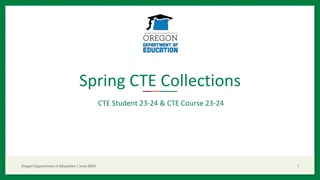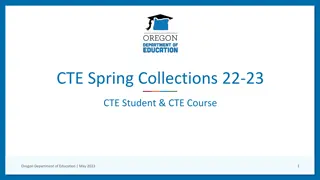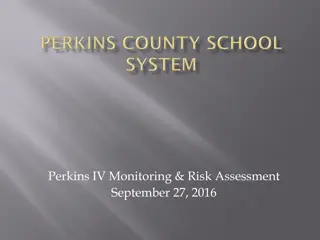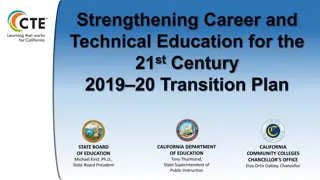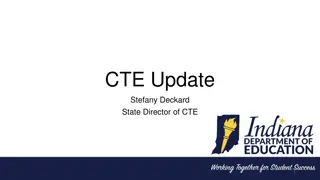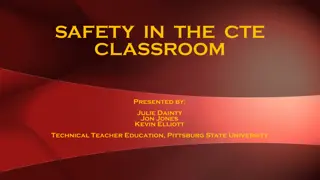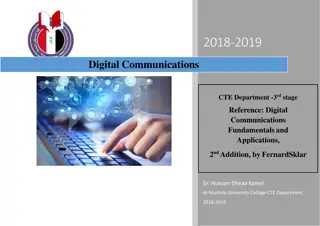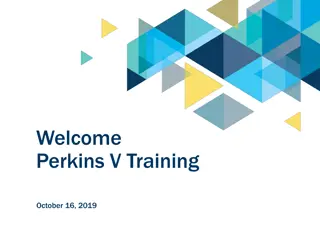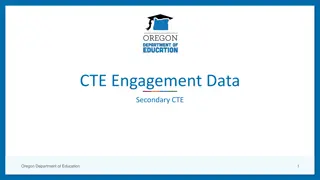Perkins V - Federal CTE Law Overview
Overview of the Perkins V federal CTE law discussing its significance, reauthorization process, key tenets, funding structure, and impact on education programs. Learn about the federal investment in Perkins, funding allocation process, and support activities funded by Perkins. Explore the state plan development and timeline under the reauthorization. Discover the role of Perkins in enhancing Career Technical Education for learners and employers nationwide.
Download Presentation

Please find below an Image/Link to download the presentation.
The content on the website is provided AS IS for your information and personal use only. It may not be sold, licensed, or shared on other websites without obtaining consent from the author.If you encounter any issues during the download, it is possible that the publisher has removed the file from their server.
You are allowed to download the files provided on this website for personal or commercial use, subject to the condition that they are used lawfully. All files are the property of their respective owners.
The content on the website is provided AS IS for your information and personal use only. It may not be sold, licensed, or shared on other websites without obtaining consent from the author.
E N D
Presentation Transcript
AN OVERVIEW OF THE NEW FEDERAL CTE LAW: PERKINS V
AGENDA What is Perkins? Perkins V Reauthorization Process & Timeline Major Tenets of Perkins V Resources & Next Steps
WHAT DOES PERKINS DO? Perkins is a federal education program that invests in secondary, postsecondary and adult Career Technical Education (CTE) programs in all 50 states, the District of Columbia and the territories Perkins is: dedicated to the continuous improvement of and relevancy of CTE to meet the ever-changing needs of learners and employers increasing learner access to high-quality CTE programs of study
HOW DOES PERKINS FUNDING WORK? Congress appropriates funds to Perkins on an annual basis States designate an eligible agency to administer Perkins and must submit a plan to the U.S. Department of Education to receive funds Locals submit an application to the eligible agency to receive funds, local recipients of Perkins funds often include: Local school districts Area technical centers Community and technical colleges Pre-apprenticeship/youth apprenticeship programs
WHAT DO PERKINS FUNDS SUPPORT? A variety of activities, including: Programs of Study Professional development Technical assistance Career exploration, guidance and advisement Data collection and analysis, including program and plan evaluation and monitoring
PERKINS REAUTHORIZATION & TIMELINE
WHAT DOES REAUTHORIZATION MEAN FOR THE STATE PLAN TIMELINE?
WHAT DOES REAUTHORIZATION MEAN FOR THE STATE PLAN DEVELOPMENT?
WHAT DOES REAUTHORIZATION MEAN FOR THE GOVERNANCE OF PERKINS? Perkins V largely retains the governance structure of Perkins IV, whereby the eligible agency maintains the ability to make key decisions about: Administration of funds from the Perkins Basic State Grant Split of funds between secondary and postsecondary CTE State plan development Local grantee oversight and technical assistance
MAJOR TENET 1: PROGRAM IMPROVEMENT Maintains commitment to programs of study Introduces comprehensive local needs assessment Increases reserve fund to spur local innovation and implement programs of study Adds new national, competitive grant program that focuses on innovation and modernization Increased focus on alignment to labor market needs Stronger focus on equity, including a new purpose on increasing opportunities for special populations
MAJOR TENET 2: FLEXIBILITY Retains governance structure and flexibility of eligible agency to determine: Secondary and postsecondary split How to leverage funds Elements of local application Expands support for career exploration to go as low as grade 5 Alignment to the Every Student Succeeds Act (ESSA) and Workforce Innovation and Opportunity Act (WIOA)
USES OF STATE LEADERSHIP FUNDS Required (5 total) Permissible (25 total) Preparation for non-traditional fields, programs for special populations Vary greatly in scope and feasibility Many retained from Perkins IV (e.g., awarding incentive grants, enhancing data systems, partnering with intermediaries, etc.) Individuals in state institutions Recruiting, preparing or retaining CTE teachers/faculty Some new uses (e.g., adoption/integration of recognized postsecondary credentials and work-based learning into programs of study, support for the integration of employability skills into CTE programs, supporting eligible recipients in eliminating inequities in student access to high-quality programs of study and effective teachers, etc.) Technical assistance Reporting on effectiveness of funds
MAJOR TENET 3: DATA & ACCOUNTABILITY Defines who is included in the accountability system Changes the process for setting performance targets Includes strengthened stakeholder engagement process Focuses on disaggregation of data Shifts the accountability indicators
SECONDARY ACCOUNTABILITY INDICATORS Graduation rates Academic proficiency Student placement A measure of CTE program quality : student attainment of recognized postsecondary credentials; student attainment of postsecondary credits in their CTE program/program of study; or percentage of students participating in work-based learning. The percentage of CTE concentrators in CTE programs that lead to nontraditional fields
POSTSECONDARYACCOUNTABILITY INDICATORS The percentage of CTE concentrators who, during the second quarter after program completion, remain enrolled in postsecondary education, are in advanced training, military service, a service program, the Peace Corps or are placed or retained in employment. The percentage of CTE concentrators who receive a recognized postsecondary credential during participation in or within 1 year of program completion. The percentage of CTE concentrators in CTE programs that lead to nontraditional fields.
RESOURCES & NEXT STEPS Find resources at: www.careertech.org/Perkins
